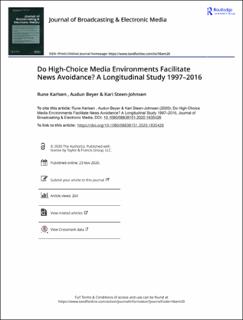| dc.contributor.author | Karlsen, Rune | |
| dc.contributor.author | Beyer, Audun | |
| dc.contributor.author | Steen-Johnsen, Kari | |
| dc.date.accessioned | 2021-01-08T07:12:32Z | |
| dc.date.available | 2021-01-08T07:12:32Z | |
| dc.date.created | 2020-08-01T13:45:44Z | |
| dc.date.issued | 2020 | |
| dc.identifier.citation | Journal of Broadcasting & Electronic Media. 2020, . | |
| dc.identifier.issn | 0883-8151 | |
| dc.identifier.uri | https://hdl.handle.net/11250/2722104 | |
| dc.description.abstract | The well-known “high-choice news avoidance thesis” and the alternative “network structure perspective” stipulate somewhat conflicting expectations about news consumption in today’s digital media systems. Based on annual survey data from Norway, the article examines news avoidance from 1997–2016, a period when digitalization processes transformed the media environment. Results show that news avoidance increased only marginally. The decrease in use of traditional media is largely compensated for by online news. However, news avoidance is increasingly polarized along educational lines, and it is unclear to what degree online news consumption equals traditional news media consumption in qualitative terms. | |
| dc.language.iso | eng | |
| dc.title | Do High-Choice Media Environments Facilitate News Avoidance? A Longitudinal Study 1997–2016 | |
| dc.type | Peer reviewed | |
| dc.type | Journal article | |
| dc.description.version | publishedVersion | |
| dc.source.pagenumber | 22 | |
| dc.source.journal | Journal of Broadcasting & Electronic Media | |
| dc.identifier.doi | 10.1080/08838151.2020.1835428 | |
| dc.identifier.cristin | 1821182 | |
| dc.relation.project | Norges forskningsråd: 259161 | |
| cristin.ispublished | true | |
| cristin.fulltext | original | |
| cristin.qualitycode | 2 | |
